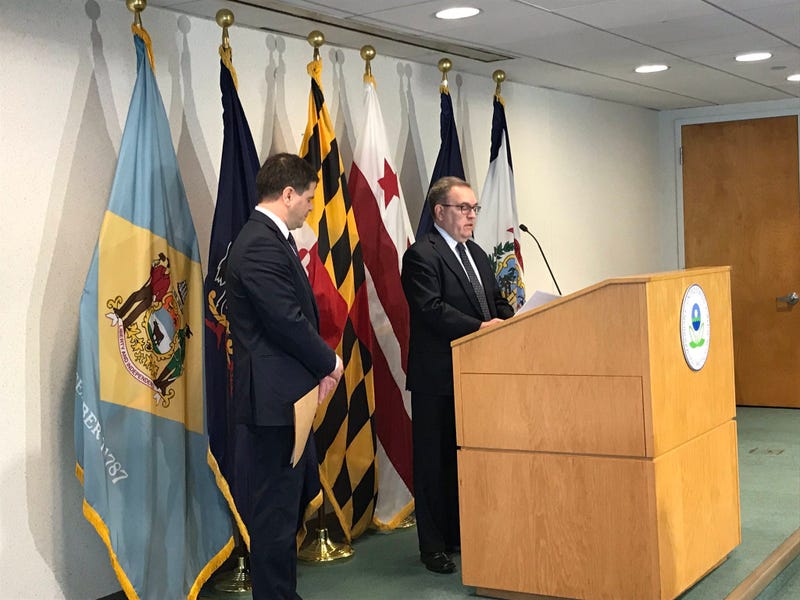
Andrew Wheeler said the immediate focus would be on two of the most common chemicals in the group, both of which have been phased out by manufacturers but remain in the environment and have suspected links to health threats ranging from cancer to decreased fertility.
Wheeler says the action plan will commit the agency to take steps to improve how the chemicals known as PFAS are monitored and detected in drinking water:
"This action plan represents a pivotal moment in the history of the agency and a pivotal moment for public health and environmental protection."
The EPA has had an advisory level for the chemicals of 70 parts per trillion, but they’ve never set an enforceable limit.
"Seven months ago, residents of Horsham, Warrington, and Warminster township poured their heart out to EPA about horrible diseases, birth defects," Cuker said. "This does nothing to address any of that."
State Rep. Todd Stephens says, as a lifelong Horsham resident, he welcomes the EPA finally taking action. He says that, until we know what these chemicals do to the human body, the only acceptable level is zero.
"I don’t think we know enough about these chemicals. And the very fact they want to research them more to me is an indicator they should not be present in our water," he said.
Several municipal water systems, such as Horsham and Warminster, have taken steps to remove the chemicals from drinking water, but Stephens says area residents are footing the bill, and he thinks the feds should be chipping in.
The EPA has faced criticism from lawmakers in both major political parties as an increasing number of states have discovered perfluoroalkyl and polyfluoroalkyl substances, known collectively as PFAS, in public water systems and private wells. PFAS are a family of chemicals found in all kinds of households items, like Teflon and some fabrics. They were also present in firefighting foam used at the Willow Grove naval air station.
Wheeler described his agency's approach as "the most comprehensive cross-agency plan to address an emerging chemical of concern ever undertaken by EPA."
"We are moving forward with several important actions, including the maximum contaminant level process, that will help affected communities better monitor, detect and address PFAS," he said.
The EPA also is moving toward listing the two common forms of PFAS, known as PFOA and PFOS, as hazardous substances and will issue interim groundwater cleanup recommendations for contaminated sites, he said. The agency will propose adding PFAS chemicals to a drinking water monitoring program and develop new methods for detecting them in water, soil and groundwater.
With the Senate considering whether to confirm Wheeler as EPA administrator, Democratic and Republican lawmakers have pressed him to establish mandatory limits for PFAS in public water systems.
The Environment and Public Works Committee's ranking Democrat, Sen. Tom Carper of Delaware, said the agency's plan takes only timid steps toward fulfilling pledges made by former EPA head Scott Pruitt, who in May 2018 described PFAS pollution as "a national priority." Pruitt said the EPA would begin evaluating the need for regulating the chemicals under the Safe Drinking Water Act.
Carper said it has taken the EPA "nearly a year just to kick the can even further down the road."
"While EPA acts with the utmost urgency to repeal regulations," Carper said, "the agency ambles with complacency when it comes to taking real steps to protect the water we drink and the air we breathe."
Republican Sen. Shelley Moore Capito, whose state of West Virginia was one of the first where PFAS contamination was linked to human health problems, said she voted for Wheeler's nomination in committee earlier this month only after he privately assured her the EPA would tackle the problem.
Capito was one of 20 senators who wrote to Wheeler demanding ceilings on two phased-out types of PFAS chemicals. They pressed Wheeler for other "immediate actions" to protect the public from other versions of the industrial compounds.
Thousands of distinct PFAS chemicals, which resist heat and repel grease, water and oil, have been in production since the 1940s. They've been labeled "forever chemicals" because they break down slowly, if at all. Testing of water systems around the nation has turned up varying levels of the compounds.
___
